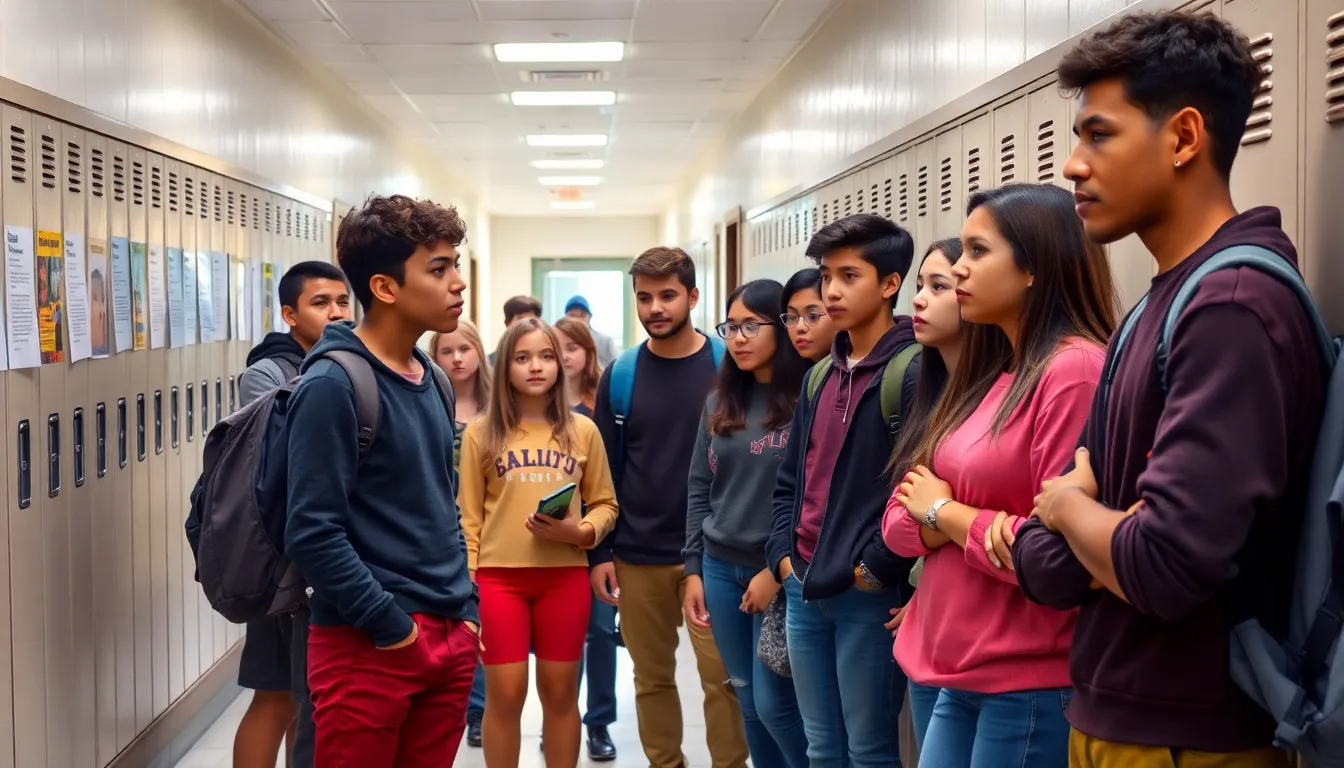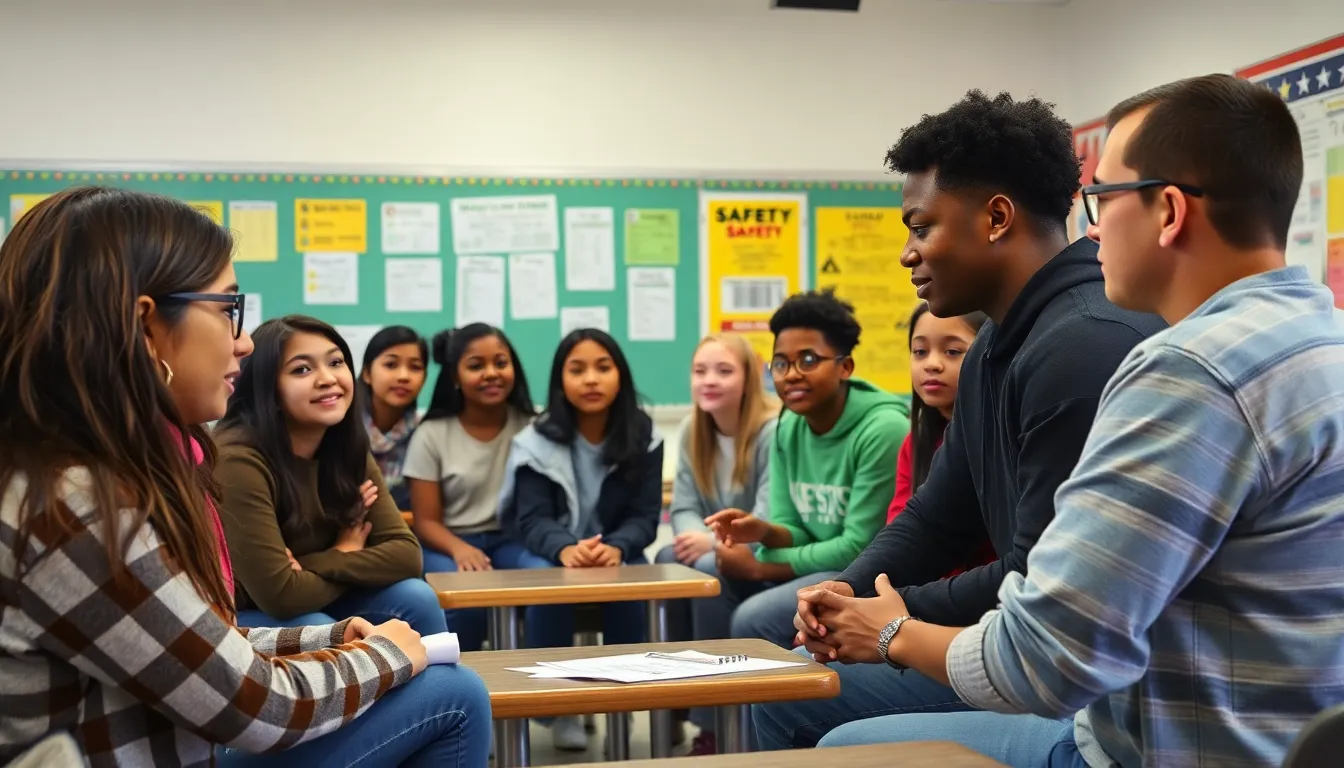High school is a whirlwind of locker slams, cafeteria chaos, and the occasional awkward dance move. But amid the laughter and learning, one thing deserves top priority: safety. With rising concerns about school security, it’s time to take a closer look at how to keep those hallways safe without turning them into a fortress.
Imagine a place where students can focus on acing that algebra test instead of worrying about what’s lurking around the corner. From innovative safety measures to engaging community programs, schools are stepping up their game. It’s not just about drills and rules; it’s about creating an environment where everyone feels secure and ready to thrive. So, let’s dive into the world of high school safety and discover how to keep the fun alive while ensuring every student can learn without fear.
Table of Contents
ToggleImportance Of High School Safety
High school safety plays a crucial role in fostering an environment conducive to learning. Ensuring a secure environment impacts students’ academic performance and emotional well-being. Effective safety measures can minimize disruptions caused by violence or bullying, allowing students to focus on their studies.
Comprehensive safety programs involve students, staff, and the community. Collaboration between these groups strengthens trust and communication, creating a supportive atmosphere. Implementing safety drills helps prepare everyone for emergencies, enhancing student and staff readiness.
Mental health resources significantly contribute to high school safety. Access to counselors and support groups aids in addressing students’ emotional needs. These resources encourage open dialogues, enabling students to express concerns without fear of judgment.
Regular assessments of school safety policies ensure they adapt to evolving challenges. By utilizing data and feedback from students and staff, schools can address emerging threats effectively. Staying informed about current statistics promotes awareness of potential risks.
Innovative technology enhances safety measures in high schools. Surveillance systems, access controls, and reporting apps provide real-time monitoring and communication. Such tools help deter incidents before they escalate, contributing to an overall safer environment.
Prioritizing high school safety benefits not only students but also families and communities. A secure school fosters stronger community ties as parents feel confident sending their children to school. Promoting safety initiatives builds a shared sense of responsibility, ultimately ensuring that high school remains a place of growth and learning.
Common Risks In High Schools

High schools face various risks that can impact student well-being and safety. Understanding these risks supports the development of effective safety measures.
Physical Threats
Violence remains a significant concern in high schools. Reports indicate that nearly 20% of students in grades 9-12 experienced bullying in 2019. Physical altercations or threats can create an atmosphere of fear. Additionally, unauthorized access to schools poses dangers. Implementing controlled access points and regular security assessments enhances student safety. Schools must also monitor campus areas where students congregate, as these can become hotspots for incidents.
Emotional Challenges
Emotional challenges significantly affect student health and academic performance. Surveys reveal that approximately 30% of high school students show signs of persistent depressive feelings. Fear of bullying or social isolation can lead to anxiety and decreased self-esteem. Developing mental health resources, such as counseling services and peer support programs, is essential. Schools should encourage open communication to identify students who may struggle emotionally, fostering a supportive environment. Addressing these emotional challenges directly correlates with improving overall student safety and well-being.
Strategies For Enhancing High School Safety
High school safety requires multifaceted approaches that integrate training, preparedness, and community involvement. Several strategies can significantly improve security and well-being in educational settings.
Staff Training Programs
Training programs for staff enhance awareness and response capabilities. Regular workshops focus on identifying potential threats and managing crisis situations. Engaging in role-play scenarios boosts confidence in real-life applications. Training prioritizes effective communication and encourages collaboration among staff. Programs should incorporate mental health awareness, crucial for recognizing student needs. Ensuring staff are trained to de-escalate conflicts reduces the likelihood of violence. Schools must continuously evaluate these training programs for relevance and effectiveness.
Emergency Preparedness Plans
Emergency preparedness plans create structured responses to crises. Schools should develop comprehensive protocols covering various scenarios, including lockdowns and evacuations. Involving local authorities in the planning process fosters cooperation. Conducting regular drills helps students and staff become familiar with procedures. Feedback after each drill identifies areas for improvement. Plans must adapt based on assessments and surveys of student concerns. Continuous updates to emergency plans reflect evolving security landscapes.
Role Of Technology In High School Safety
Technology significantly enhances high school safety measures, addressing pressing security concerns. Schools increasingly adopt solutions that leverage advanced tools to protect students.
Surveillance Systems
Surveillance systems play a pivotal role in maintaining security within schools. These systems provide real-time monitoring of hallways and entry points, deterring potential incidents. Many schools implement high-definition cameras, enabling clear footage that aids in identifying threats. In addition to cameras, emergency alert systems link with surveillance feeds, facilitating swift responses during crises. Effective usage of surveillance technology can reduce incidents of bullying and violence, promoting a secure environment.
Communication Tools
Communication tools offer critical support for safety in high schools. These platforms allow for seamless reporting of suspicious activities, enhancing trust among students and staff. Apps designed for anonymous reporting enable students to voice concerns without fear of repercussions. Instant messaging systems ensure rapid dissemination of information during emergencies, keeping everyone informed and calm. By fostering open lines of communication, schools create a proactive approach towards identifying and addressing safety issues.
Community Involvement In High School Safety
Community involvement plays a crucial role in enhancing high school safety. Local businesses and organizations can partner with schools to develop programs that address specific safety needs. Often, this collaboration leads to resource sharing, connecting schools with funding for security upgrades or mental health initiatives.
Involve parents through regular meetings to discuss safety concerns. Engaging families fosters a collaborative atmosphere, allowing them to voice their opinions and recommendations. These contributions can guide schools in adopting effective safety protocols.
Student input remains vital in shaping safety initiatives. They can assist in creating peer support programs that encourage openness among classmates. Establishing clubs focused on safety awareness can promote a culture of vigilance and empathy.
Regular community events aimed at safety education strengthen bonds between schools and residents. These initiatives might include workshops on emergency response or presentations on mental health resources. Such gatherings inform everyone about available support while building trust.
Involvement of law enforcement amplifies school safety efforts. Officers can conduct workshops on conflict resolution and self-defense, fostering positive relationships. Their presence at school events reassures students and parents alike.
Regular assessments of community programs help adapt responses to emerging issues. Data trends reveal areas requiring attention, ensuring ongoing improvement. Collecting feedback from students, parents, and staff contributes to an evolving safety framework.
Enhanced community involvement nurtures a culture of safety within schools. Shared accountability among students, parents, and staff creates a safer learning environment. Together, they foster an atmosphere where academic success and emotional well-being thrive.
High school safety is a shared responsibility that requires the collective efforts of students, staff, families, and the community. By prioritizing innovative safety measures and mental health resources, schools can create an environment where students feel secure and supported. Engaging the community in safety initiatives fosters trust and collaboration, enhancing the overall safety framework.
Continuous evaluation and adaptation of safety policies ensure schools are prepared to face emerging challenges. When everyone works together, the focus can remain on academic success and emotional well-being, leading to a thriving educational atmosphere. A commitment to safety not only protects students but also strengthens the bonds within the community, paving the way for a brighter future.




